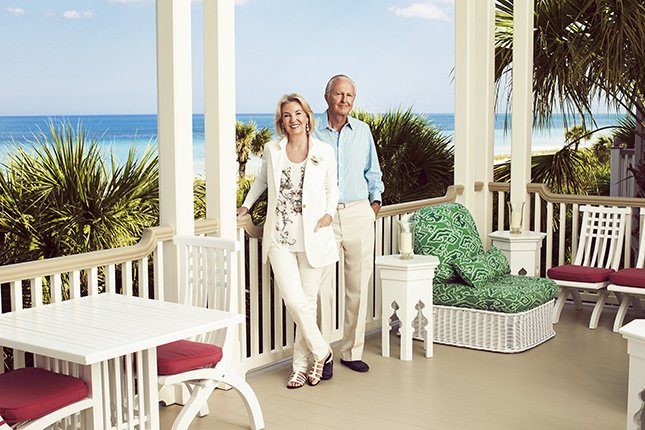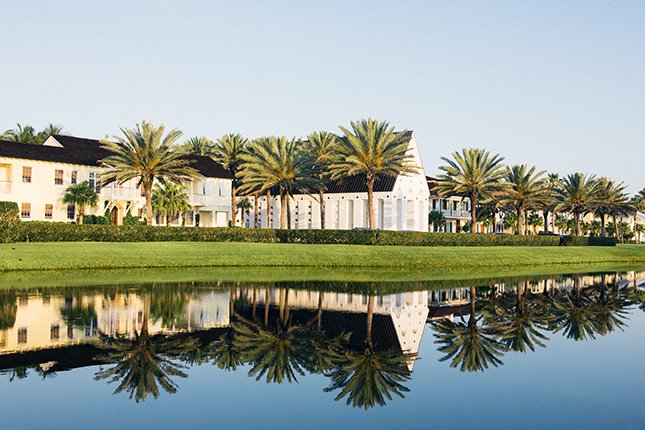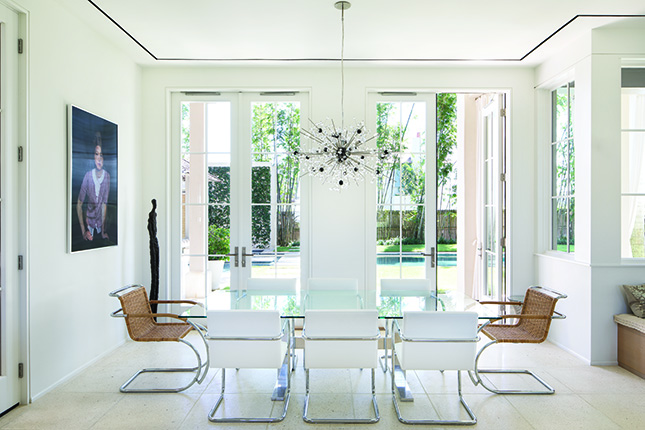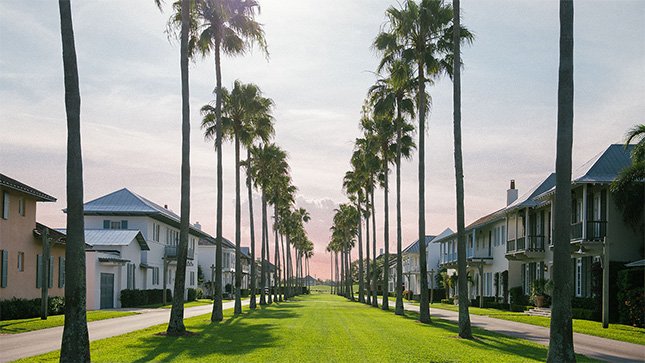A casual visitor probably wouldn’t guess that Windsor, a private enclave on Florida’s Atlantic Coast just north of Vero Beach, pioneered modern urban planning. At first glance, the picture-perfect village, featuring 350 unembellished homes on densely organized lots, eco-friendly design and landscaping, walking trails through native hammocks, and a placid town center with an amphitheater and a general store, seems freshly built. Yet in the 30 years since this resort began, many of its then-radical features have become the new normal.
“We had been looking for a place to establish a winter home to escape the brutal Canadian winters and play polo,” says Hilary Weston, who founded Windsor on a 416-acre grapefruit plantation with her husband Galen. At first, the billionaire couple, whose business holdings include Selfridges and Brown Thomas department stores in the U.K. and Ireland, only wanted to build a compound for family and friends. The vision soon led to a larger multigenerational resort that combined their passions: sports—particularly polo, tennis and golf—beach living, arts and environmental awareness. For them, the key to creating a community that represented their passions even while maintaining a relaxed lifestyle was the nascent New Urbanism movement.


A response to 20th century urban sprawl and car dependency, New Urbanism first arose in the 1980s with the town of Seaside, Fla., recognizable for its Rockwellesque aesthetic and pedestrian-focused grid. (Years later it would be the filming location of the The Truman Show.) If you’ve ever seen the “live-work-play” motto on a real estate ad, you can trace it directly to New Urbanism. Because renowned urban designers Andrés Duany and his wife Elizabeth Plater-Zyberk, principals of Miami-based firm DPZ, planned Seaside, the Westons tapped them to work on Windsor. Rather than concentrating the community around a golf course, as was the trend of other resorts at the time, the Westons wanted a strict planning code that would allow them to create a village center and provide an architectural character inspired by America’s earliest cities such as Charleston and Savannah, as well as the British West Indies. Today Windsor calls this design “Anglo-Caribbean.”
“The Westons actually took a tremendous risk,” says Duany, who cofounded the Congress for the New Urbanism in 1993. “There are so many of these communities now—this is a normative way of designing new resorts. But at the time it was pioneering.”
The code’s strict development guidelines, ranging from building materials to window components, are one of the principal reasons for Windsor’s long-standing appeal. While setting certain standards, it allows any architect a homeowner chooses to express his or her client’s desires, providing visual diversity while ensuring a cohesive character. “That is why Windsor looks like an authentic town, because it is designed by many hands,” Duany says.


Although it is restrictive, the code has changed slightly, says Windsor’s VP of construction, Mark Justice, to meet “changing building standards without compromising original design intent.” Duany also praises the code for introducing courtyard homes, which offer privacy within a smaller piece of land, and for avoiding tired Florida trends that haven’t aged well. “Who wants to live in some kind of Mediterranean Baroque palace? Windsor dodged that bullet. All the young people now want to live in very simple houses.”
That’s not to say that Windsor hasn’t evolved over time. When it opened in 1989 primarily as a polo club, Windsor indulged in some excess: Prince Charles visited annually to play his favorite sport, and luxury travel guru Geoffrey Kent (of tour operator Abercrombie & Kent), who was another cofounder of Windsor and captain of the prince’s Windsor Park polo team, promoted the development to the hilt. Those royal ties (the Westons hold the lease on Fort Belvedere, an 18th-century estate near Windsor Castle in England) as well as the influx of socialites from nearby Palm Beach initially brought the development under the media lens.
That strategy may have helped put Windsor on the map, but it feels at odds with the community’s present character. Preferring a grapevine approach to attract new residents, Windsor is more of a secret today than in the George H.W. Bush era—a style that charms many West Coast and Silicon Valley transplants whom I met at Windsor while visiting earlier this year. Equestrian sports are still a focus, with newly expanded stables, paddocks and lawns thanks to the polo’s recent rise in popularity; the tennis center designed by pro Stan Smith is also going strong, as are child and young adult programming to engage younger generations.

Another component that Windsor is betting its future on is a noteworthy arts and culture program. Thanks to an on-site gallery above the clubhouse, Windsor can host works of art and welcome its creators—and these exhibits are open to the general public. In a partnership with London’s Royal Academy of Arts, Windsor exhibited this spring Sir Michael Craig-Martin’s Present Sense, a collection of whimsical sculptures placed throughout the community and prints displayed at the gallery. Previous featured artists have included Grayson Perry, Jasper Johns and Per Kirkeby. Other unique programming includes wine tastings by prestigious wineries such as Bryant Estate.
But no one is more aware than Duany that New Urbanist plans alone won’t create a utopia. An urban plan must be managed carefully, with a clear vision and the ability to pivot when necessary. Seaside, for example, drowns in maddening car traffic every summer as tourists pour in, paralyzing its town center. But Duany is confident that Windsor’s management and the Westons’ vision steers the community away from those pitfalls. “People call me when a place is in trouble. I’m like an ER doctor,” Duany says, “but Windsor has had virtually no problems.”






